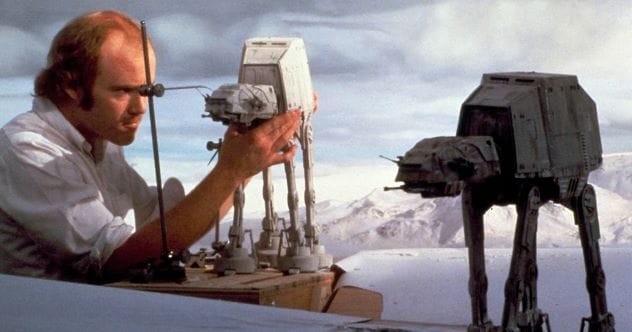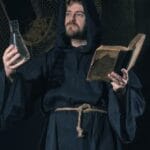Visual effects in movies are often a topic of conversation these days, frequently accompanied by complaints. We’ve become so accustomed to CGI and 3D graphics that their obvious use can sometimes feel cheap. Many VFX artists believe they’ve done a good job when people don’t notice the effects, which can be unfortunate considering the amount of work involved.
However, things were different in the past. While we might complain about fake-looking CGI, 3D graphics were either entirely unconvincing or nonexistent. Creating convincing effects required a healthy dose of suspension of disbelief. Yet, these older techniques have aged remarkably well, often looking good despite not seeming realistic. Let’s explore ten notable techniques that showcase creativity and ingenuity.
Puppets
Puppets might not be the first thing that comes to mind when considering special effects, especially those meant to be convincing. Often associated with stylized filmmaking, as seen in The Dark Crystal, puppets are surprisingly versatile. Although they’ve become less popular since the rise of CGI, puppetry played a crucial role in creating some of film’s most iconic effects and characters.
From Yoda in the original Star Wars trilogy to dinosaur shots in Jurassic Park (including the T-Rex) and the Pale Man in Pan’s Labyrinth, puppetry has achieved far more than just The Muppets. Master puppeteers, the unique look of well-made puppets, and the physical presence of a tangible object combine to create an immersive and convincing experience.
The control of master puppeteers, the usability and unique, textured look of well-made puppets, and the actual, physical presence of a tangible object combine to create something that has the potential of being a lot more immersive and convincing than old children’s shows would have you believe. [1]
Green/Blue Screen
Green and blue screens are staples of modern filmmaking. Jokes abound about entire movies filmed on green sets, which isn’t entirely unfounded given their prevalence in recent years. However, these chroma key screens have been around for nearly a century!
Their use in the 1930s was similar to today’s technique of layering picture elements. Even before green and blue screens, double exposure was used in photography as early as the 1860s and in films like Edwin S. Porter’s The Great Train Robbery (1903). By the ’30s, blue screen technology was advanced and used in films like 1933’s King Kong, gaining further popularity during the original Star Wars trilogy.
The color shifted from blue to green due to their contrast with human skin tones. Still, this technique, often seen as a modern element, has been a constant presence throughout motion picture history. [2]
Forced Perspective
Forced perspective is a deceptively simple technique that’s been around since the early days of photography. The idea is straightforward: objects farther away appear smaller, while those closer seem larger.
The usage is nuanced and widespread. From the height differences in The Lord of the Rings, where hobbits appear shorter than Gandalf, to Disney’s Darby O’Gill and the Little People (1959), forced perspective has been used for decades to convincingly portray size differences through carefully crafted sets and optical trickery.
This technique isn’t just for contrasting large and small people. Combined with miniatures, props, and puppetry, it can create the illusion of a giant destroying a city without modern digital effects. While less common today, it remains a clever tool for effects artists. [3]
Paintings
Paintings have been used extensively in film history, often unnoticed. Real-life paintings have served as iconic movie backgrounds, meticulously crafted by artists. Few viewers recognize their work.
Star Wars is a well-known example, pioneering many modern effects techniques. Even today, matte shots are popular, evolving from acrylic paint on glass to 3D renders and digital paintings.
Industrial Light & Magic, known for Raiders of the Lost Ark and Star Wars, wasn’t the first to use them. Georges Méliès used paintings as backgrounds in the early 1900s. [4]
Costumes
Fashion has influenced movies, but elaborate clothing isn’t always about faking the fantastical. Before CGI could bring monsters and creatures to life, costume artists and actors in intricate suits took on the task.
While not always convincing, these costumes retain a certain charm. Beyond cheesy films, actors in detailed suits were responsible for creating iconic creatures.
Examples include Ishirō Honda’s Godzilla and the xenomorph from Alien, with a tall actor, Bolaji Badejo, bringing the iconic creature to life. Though elaborate creature costumes might seem cheesy today, their legacy is undeniable. [5]
Miniatures
Miniatures have contributed far more than just tabletop games. Small figurines combined with forced perspective have been the backbone of many older films that we often take for granted.
Georges Méliès is credited with pioneering many filmmaking techniques still used today.
Miniatures were essential to his widely known film, A Trip to the Moon (1902), which showcased early special effects. This led to their use in films like 2001: A Space Odyssey’s space station and Star Wars’ spaceships. [6]
Rotoscoping
Tracing over images, known as rotoscoping, is a long-standing technique. It allowed artists to directly change and interact with film footage.
Before the digital age, film footage was projected onto glass and traced manually. This was used for early Disney films like Alice in Wonderland, Cinderella, and Fantasia, as well as Star Wars’ lightsabers and Tron’s primitive CGI.
Rotoscoping became a digital process in the 1990s, revolutionizing film forever. [7]
Stop Motion
Stop motion is still used today as a niche animation form. Entire films are constructed by manually adjusting models frame by frame, taking pictures, and combining them to create moving footage.
Despite the manual labor, stop motion is a timeless art. It was used for various special effects before CGI.
The Terminator from The Terminator is a famous example. The technique has improved, effectively portraying a menacing, robotic machine. [8]
Animatronics
Animatronics are impressive, and may look better than CGI even today. These effects have left a mark on blockbuster movies, with fans advocating for their use over 3D renders.
Complex robots moving in real-time are impressive. The reality of what skilled creators have achieved surpasses imagination.
Animatronics enhanced Jurassic Park’s visuals. John Carpenter’s The Thing (1982) also stands out, with terrifying, visceral creature effects. While 40 years old, the film’s fans are dedicated to its style and visuals. Its modern remake failed to capture the original’s shocking atmosphere. [9]
Creative Resourcefulness
A list of impressive techniques wouldn’t be complete without recognizing human ingenuity. Every great film and effect is made possible by creativity.
From the rotating set of Stanley Kubrick’s 2001: A Space Odyssey, to the filming of The Lord of the Rings, which used simple perspective to portray different humanoids, creativity was key. The horror of The Thing used everything from makeup to sculptures, mayonnaise, and strawberry jam, landing its creator in the hospital due to exhaustion. The list goes on.
Film effects are made complete by the artistic creativity of the people behind them, who use everyday objects to create representations of things that don’t even exist. [10]
In conclusion, these ten techniques showcase the ingenuity and creativity that went into faking the fantastical in old films. From puppets and miniatures to forced perspective and creative resourcefulness, these methods demonstrate a remarkable ability to create convincing illusions without the use of modern CGI. These techniques not only stand the test of time but also remind us of the artistry and resourcefulness of filmmakers in a pre-digital era.
Which of these old-school techniques do you find most impressive? Leave your comment below and share your thoughts!










